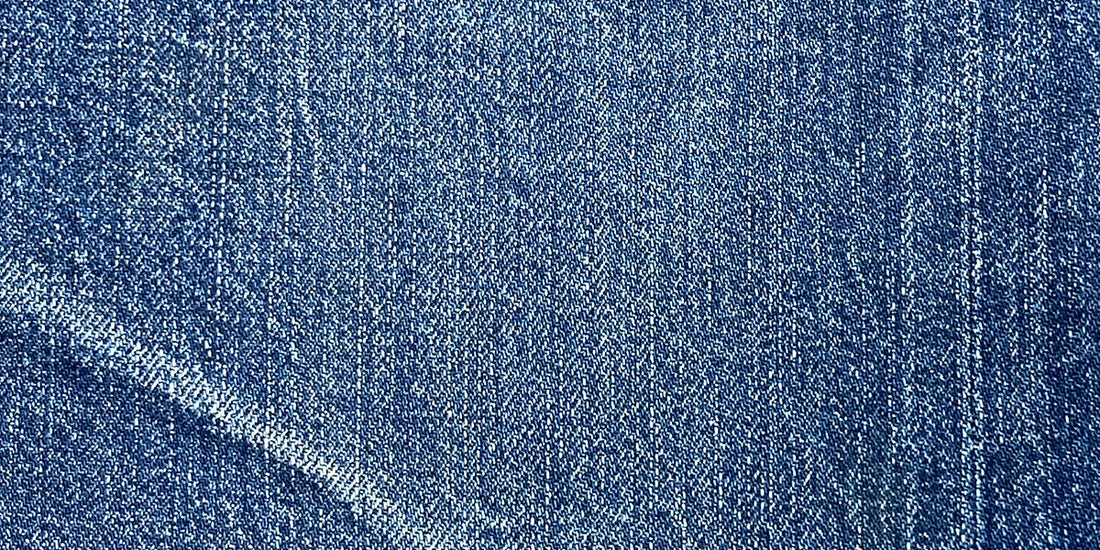
A.M.Co 9oz Blue Denim by O.A — The Secret Behind “9 Ounces”
Share
When you see “9oz” on a denim label, you might think of something light, maybe even too light for serious jeans.
But here’s the truth: this 9 ounces is nothing of the sort.
It comes from an old American linear yard standard, and in today’s terms it’s the equivalent of roughly 11.6oz in loomstate and about 12.75oz once sanforized.
In other words—solid, substantial denim.
A Story That Began in the Mills of Amoskeag
In the late 18th century, Britain’s booming cotton industry crossed the Atlantic, taking root in Massachusetts and beyond.
By 1831, the Amoskeag Manufacturing Company (A.M.Co) was incorporated in neighboring New Hampshire. With deep capital and aggressive acquisitions, it grew into the largest textile city in the world by the mid-19th century.
Levi Strauss & Co. and many other workwear makers sourced fabric from these mills. Amoskeag denim was considered the gold standard—literally nicknamed “Gold Medal” quality.
But prosperity fades. By the early 20th century, the mills were in decline, and today their red-brick buildings stand quietly along the Merrimack River, preserved as a reminder of an industrial past.
Our Visit, and an Unexpected Discovery
In the fall of 2022, we traveled to Manchester, New Hampshire.
Walking along the riverfront, the mill buildings felt like stepping back into the 19th century.
Inside the archives, you fill out a request slip, and a staff member brings each precious volume from the shelves.
One of them was the size—and weight—of a suitcase.
As we carefully turned its thick pages, we found something remarkable: the original recipe for denim.

What Was the “Linear Yard” Standard?
Back then, an “ounce” didn’t mean what it does today.
The difference lies in the measuring area:
| Era | Base Area | How It Was Measured | Notes |
|---|---|---|---|
| Old U.S. textile trade | Weight per linear yard (fixed width) | Width depended on the fabric itself—e.g., 28" × 36" | Common for denim & cotton duck; narrower widths looked “lighter” on paper |
| Modern denim industry | Weight per square yard (36" × 36") | Same base area regardless of fabric width | Globally standardized; easier for comparing thickness & density |
Translating 9oz (Linear Yard) to Today’s Scale
Take a 28-inch-wide denim:
-
A linear yard of this fabric has less surface area than a modern square yard.
-
When you scale the weight to today’s square yard standard, 9oz becomes about 11.6oz in loomstate.
-
Most modern jeans are sanforized (pre-shrunk). After accounting for roughly 9% shrinkage, that same fabric measures about 12.75oz.
So, old 9oz ≈ modern 13oz in the jeans you’re used to seeing.

Why Was the Linear Yard “Fixed in Width”?
From the 19th century through the early 20th century, all woven fabrics were produced on shuttle looms. Due to their mechanical design, the fabric width was essentially fixed.
For denim, a width of 27 to 30 inches was most common, and each mill’s looms determined a consistent width for all its output. Product specifications were standardized to match these fixed widths.
Why This Wasn’t a Problem at the Time
Most mills operated with similar-width looms, so even if there were slight variations—say, 27 inches vs. 29 inches—the difference was negligible for weight comparisons or trade. In fact, trade practices and contracts were tailored to specific mills or standards, allowing such width differences to be absorbed seamlessly within the commercial system.

Why Fixed Widths Disappeared
By the mid-20th century, shuttle looms were replaced by more efficient projectile and rapier looms, which could weave much wider fabrics. In the era of mass production and global distribution, it became common for the same fabric to be woven in multiple widths depending on its intended market or application, eliminating the necessity of a fixed width.
At the same time, the growth of international trade and the adoption of military procurement standards demanded a fair, universal unit of measurement for fabrics of varying widths. This led to the gradual adoption of the square-yard standard—measuring weight per 36×36 inches—making width irrelevant to weight classification. By the early 1960s, the square-yard standard had become the global norm, and the definition of “ounce” in textiles was unified to the modern form we use today.
The Ounce Illusion
Most people today encounter denim that’s already sanforized.
If you’re familiar with “13oz denim” from the rack, this fabric will feel just as substantial—because in practical terms, it is.
The lower number on our label isn’t because the fabric is thin—it’s because the measuring system was different.
That’s the ounce illusion: same fabric, different math, very different impression.

When Was the Linear Yard Standard Used?
-
Mid-19th century to 1940s — firmly established during the era of narrow looms
-
Late 1930s to 1950s — square yard standard appears alongside it, driven by military specs and international trade
-
By the early 1960s — complete shift to square yard measurement; ounce definition unified with today’s system
Recreating the Past
For this special project, we took that rediscovered recipe and those 19th-century swatches as our starting point.
We tested yarn choices, adjusted weave density, and studied color tone—refining every element until the texture and structure felt true to the original, yet achievable with today’s production environment.
The result is A.M.Co 9oz Blue Denim by O.A.
A fabric that carries the weight of history, in both senses of the word.

In short:
-
The “9” in A.M.Co 9oz is an old American linear yard figure.
-
In today’s terms: ~11.6oz loomstate, ~12.75oz sanforized.
-
The difference is a matter of measurement and finishing, not actual substance.

